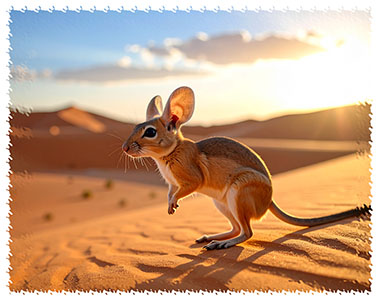

Jerboa Plush Toys are at Animals n More.
The jerboa is another noted leaper of the rodent world, like the jumping mice of the meadows and woodlands. In contrast to these animals, the jerboa has chosen as its homeland not only the hottest places on earth, but also the driest and most barren ones. It loves the arid deserts of the Old World, and appears able to get along completely without water. Jerboas do not drink water but instead get their water intake from the food they eat.
Of all the rodents, this kangaroo-like creature is
perhaps the most highly developed for getting around on two feet. (As a matter of fact, its family name, Dipodidae, means "two-footed.") Its hind limbs are large and very long. Its front limbs are correspondingly smaller, so that the animal could hardly walk on all fours if it had to.
The jerboa prefers to stand up on its hind legs and hop along, covering from two to six feet in a single jump. Its lengthy tail has a neat little brush at the tip; not only does the tail give the jerboa support when it is standing - it also helps the animal to maintain its balance as it leaps along. It has thick hair on its feet, which absorbs some of the landing shock and serves to give a grip on shifting sand.
The little plush jerboa you see here is a Folkmanis puppet. Check our sponsor's online Gift Shop to see if we have any Jerboas in stock.
Few people ever see a jerboa, even in localities where it is common, because this mammal holes up in its den under the ground during the intense heat of the desert day; it comes out only after sunset and makes sure to retire before sunrise. Furthermore, it leaves no trace of its activities. Although the jerboa is a social animal, there are no telltale runways and, when it retires for the day, it closes up the entrance to its burrow to keep out the hot sunlight.
At night the jerboa is very fond of rolling in the cool sand and scratching itself. It will lie down on the ground, leisurely stretch out its long legs one at a time, and scratch and comb them from tip to toe with its front paws. It also uses its front paws to hold the grass seeds on which it feeds.
If you should ever meet the jerboa in its home territory, generally North Africa and Asia, you would find it to be a medium-sized rodent, from two inches up to eight in head and body length. Its tail, usually about two inches longer than the head and body, is round for most of its length and broadly tufted at the tip with long black and white hairs.
The rest of the jerboa's appearance suggests its home and habits. Its ears are comparatively enormous in size - a trait we have found in other desert animals - and may equal half the length of the head and body, in some species. The eyes are large, as they often are in animals active by night. Its color varies more or less from locality to locality, but it is usually in shades of buff mixed with black or pale russet, and the under parts are white.
Most, if not all, jerboas sleep through the cold winter months, especially in the northern part of the range. Life begins again in April, when these animals come out of hibernation. The males are the first to appear and expend great energy in their search for a prospective mate. Very little is known about the breeding habits of these animals, but the young are born some 42 days after mating time.
A female breeds twice in the summer, and raises from two to six young. Gestation time is between 25 and 35 days. Like most mammals, females nurse and care for their young at least until they are weaned.
They can run up to 15 mph. They have excellent hearing and can avoid nocturnal predators, such as owls, foxes, cats, jackals and snakes. Lifespan is from 2 to 3 years.
Desert Intro
Armadillo | Desert Tortoise | Gecko | Gila Monster | Horned Lizard
| Jerboa | Kangaroo Rat | Rattlesnake | Roadrunner | Scorpion | Tarantula



